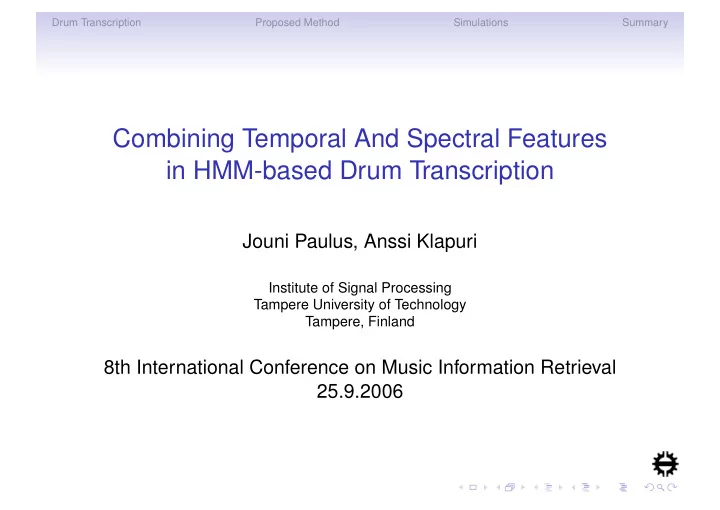

Drum Transcription Proposed Method Simulations Summary Combining Temporal And Spectral Features in HMM-based Drum Transcription Jouni Paulus, Anssi Klapuri Institute of Signal Processing Tampere University of Technology Tampere, Finland 8th International Conference on Music Information Retrieval 25.9.2006
Drum Transcription Proposed Method Simulations Summary Drum Transcription Problem • Input: audio • Anything from individual drum hits to polyphonic music • Output: symbolic representation of the drums • Temporal locations of drum events • Content of drum events (which drums were played) • Applications • Symbolic information of drum content in masses of existing audio • Re-using drum patterns from existing audio • Drum replacement in audio
Drum Transcription Proposed Method Simulations Summary Existing Methods, some examples • Classifiers for individual hits (Herrera et al. ICMAI 2002) • Onset detection, classification (Gillet et al. ICASSP 2004, Tanghe et al. MIREX 2005) • Onset detection, template adaptation recognition (Zils et al. WedelMusic 2002, Yoshii et al. ICASSP 2006) • Onset detection, localised models (Sandvold et al. ISMIR 2004) • Spectrogram decomposition (Virtanen ICMC 2003, FitzGerald PhD 2004, Dittmar et al. AES 2004, Paulus et al. EUSIPCO 2005) • HMMs, no onsets (Paulus ICASSP 2006) • Common for all: used features are from short time frames
Drum Transcription Proposed Method Simulations Summary TRAPS • TempoRAl PatternS, energy evolution on narrow subbands. • Human hearing bandwise. • Drum hits temporal events, no stationary spectrum Conventional features Classifier Frequency TRAPS Time Classifier
Drum Transcription Proposed Method Simulations Summary Base System (from ICASSP 2006) • Model all combinations of target drums with HMMs • Spectral features (MFCCs etc.) • GMMs to model observations • Background model when no drums are playing • Using the models, cover the whole duration of the signal comb 1 comb N silence
Drum Transcription Proposed Method Simulations Summary Temporal Features • Subband envelopes • Bank of 1/3-octave bandpass filters, • Low-pass and decimate, compress, temporal differentiation • → Impulsive sound events visible • Shift-invariant feature from frames of envelopes • Event location within frame will vary • Magnitude spectrum of the envelope • Reduce dimensionality (correlation, large amount of data) • Combine bandwise features, train drum presence detector GMMs for all target drums
Drum Transcription Proposed Method Simulations Summary Proposed System Block Diagram GMMs transition probabilities drum HMMs input signal model sequence spectral observation decoding features likelihoods TRAPS observation features likelihoods TRAPS GMMs proposed extension
Drum Transcription Proposed Method Simulations Summary Simulation Results • Compare the baseline, baseline with TRAPS added, and a “detect onsets & classify” -system F-measure (%) simple complex RWC drums drums Pop baseline HMM 93.4 84.0 66.8 HMM+TRAPS 92.9 85.2 69.7 SVM (Tanghe et al.) 85.5 76.4 65.1
Drum Transcription Proposed Method Simulations Summary Summary • Many of earlier drum transcription systems have used only features from short frames. • Short frames fit for stationary spectrum, drum hits are temporal events. • Proposed incorporating long-term temporal features to HMM-based recogniser. • The proposed addition improves results slightly. • Demos
Recommend
More recommend